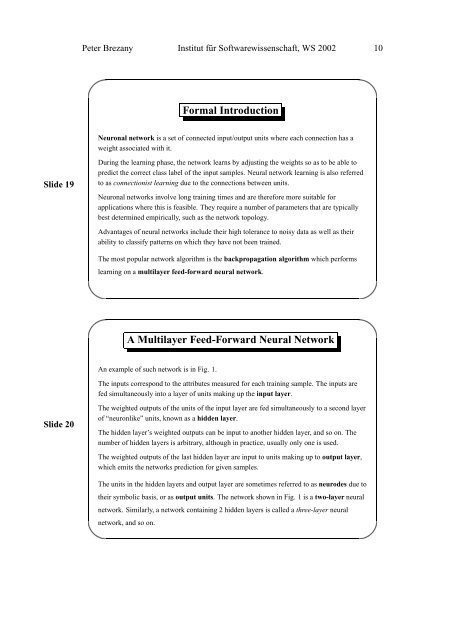CLASSIFICATION AND PREDICTION - Universität Wien
CLASSIFICATION AND PREDICTION - Universität Wien
CLASSIFICATION AND PREDICTION - Universität Wien
Create successful ePaper yourself
Turn your PDF publications into a flip-book with our unique Google optimized e-Paper software.
Peter Brezany Institut für Softwarewissenschaft, WS 2002 10<br />
Formal Introduction<br />
Neuronal network is a set of connected input/output units where each connection has a<br />
weight associated with it.<br />
Slide 19<br />
During the learning phase, the network learns by adjusting the weights so as to be able to<br />
predict the correct class label of the input samples. Neural network learning is also referred<br />
to as connectionist learning due to the connections between units.<br />
Neuronal networks involve long training times and are therefore more suitable for<br />
applications where this is feasible. They require a number of parameters that are typically<br />
best determined empirically, such as the network topology.<br />
Advantages of neural networks include their high tolerance to noisy data as well as their<br />
ability to classify patterns on which they have not been trained.<br />
The most popular network algorithm is the backpropagation algorithm which performs<br />
learning on a multilayer feed-forward neural network.<br />
A Multilayer Feed-Forward Neural Network<br />
An example of such network is in Fig. 1.<br />
The inputs correspond to the attributes measured for each training sample. The inputs are<br />
fed simultaneously into a layer of units making up the input layer.<br />
Slide 20<br />
The weighted outputs of the units of the input layer are fed simultaneously to a second layer<br />
of “neuronlike” units, known as a hidden layer.<br />
The hidden layer’s weighted outputs can be input to another hidden layer, and so on. The<br />
number of hidden layers is arbitrary, although in practice, usually only one is used.<br />
The weighted outputs of the last hidden layer are input to units making up to output layer,<br />
which emits the networks prediction for given samples.<br />
The units in the hidden layers and output layer are sometimes referred to as neurodes due to<br />
their symbolic basis, or as output units. The network shown in Fig. 1 is a two-layer neural<br />
network. Similarly, a network containing 2 hidden layers is called a three-layer neural<br />
network, and so on.




